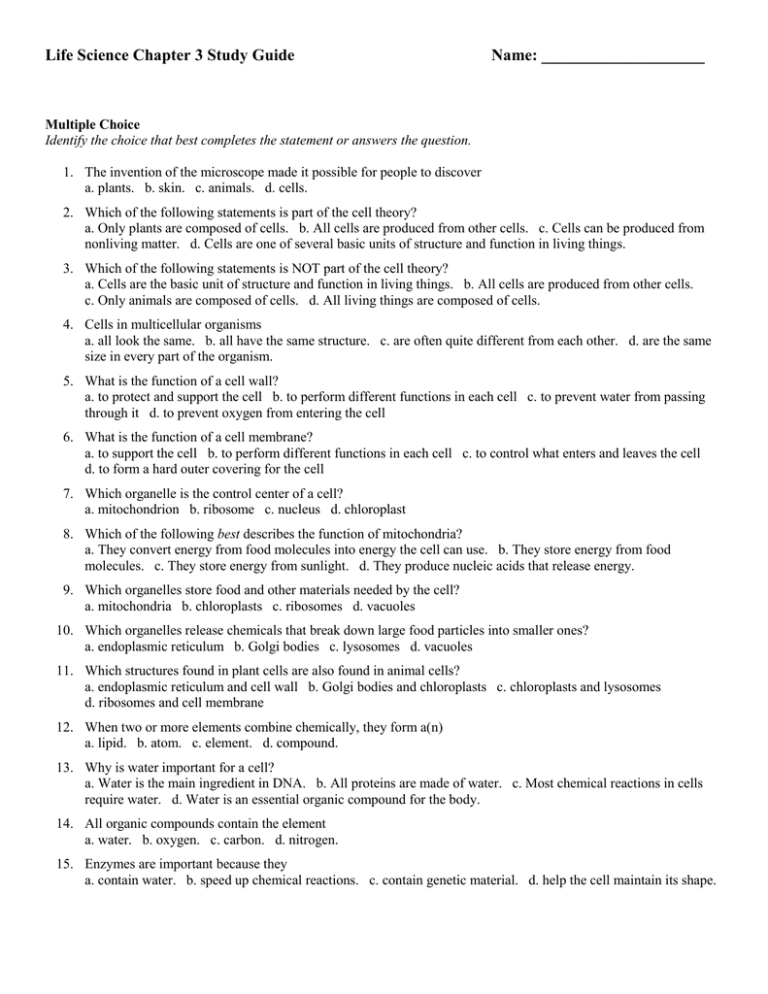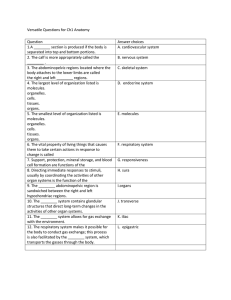Life Science Chapter 3 Study Guide
advertisement

Life Science Chapter 3 Study Guide Name: ____________________ Multiple Choice Identify the choice that best completes the statement or answers the question. 1. The invention of the microscope made it possible for people to discover a. plants. b. skin. c. animals. d. cells. 2. Which of the following statements is part of the cell theory? a. Only plants are composed of cells. b. All cells are produced from other cells. c. Cells can be produced from nonliving matter. d. Cells are one of several basic units of structure and function in living things. 3. Which of the following statements is NOT part of the cell theory? a. Cells are the basic unit of structure and function in living things. b. All cells are produced from other cells. c. Only animals are composed of cells. d. All living things are composed of cells. 4. Cells in multicellular organisms a. all look the same. b. all have the same structure. c. are often quite different from each other. d. are the same size in every part of the organism. 5. What is the function of a cell wall? a. to protect and support the cell b. to perform different functions in each cell c. to prevent water from passing through it d. to prevent oxygen from entering the cell 6. What is the function of a cell membrane? a. to support the cell b. to perform different functions in each cell c. to control what enters and leaves the cell d. to form a hard outer covering for the cell 7. Which organelle is the control center of a cell? a. mitochondrion b. ribosome c. nucleus d. chloroplast 8. Which of the following best describes the function of mitochondria? a. They convert energy from food molecules into energy the cell can use. b. They store energy from food molecules. c. They store energy from sunlight. d. They produce nucleic acids that release energy. 9. Which organelles store food and other materials needed by the cell? a. mitochondria b. chloroplasts c. ribosomes d. vacuoles 10. Which organelles release chemicals that break down large food particles into smaller ones? a. endoplasmic reticulum b. Golgi bodies c. lysosomes d. vacuoles 11. Which structures found in plant cells are also found in animal cells? a. endoplasmic reticulum and cell wall b. Golgi bodies and chloroplasts c. chloroplasts and lysosomes d. ribosomes and cell membrane 12. When two or more elements combine chemically, they form a(n) a. lipid. b. atom. c. element. d. compound. 13. Why is water important for a cell? a. Water is the main ingredient in DNA. b. All proteins are made of water. c. Most chemical reactions in cells require water. d. Water is an essential organic compound for the body. 14. All organic compounds contain the element a. water. b. oxygen. c. carbon. d. nitrogen. 15. Enzymes are important because they a. contain water. b. speed up chemical reactions. c. contain genetic material. d. help the cell maintain its shape. 16. Sugar molecules can combine with one another to form large molecules called a. proteins. b. starches. c. enzymes. d. lipids. 17. Which term refers to the movement of molecules from an area of higher concentration to an area of lower concentration? a. collision b. diffusion c. active transport d. concentration 18. Which term refers to the diffusion of water molecules through a selectively permeable membrane? a. osmosis b. engulfing c. active transport d. passive transport 19. Which term refers to the movement of materials through a cell membrane without using the cell’s energy? a. concentration b. collision c. active transport d. passive transport 20. The invention of the light microscope differed from earlier microscopes as it a. did not use an oil lamp for lighting. b. used more than one lens. c. focused light up through a specimen. d. featured a tube with an eyepiece. 21. Though cells in living things are put together in many ways to form different structures, all cells a. are identical in size. b. carry out the exact same function. c. carry out similar life processes. d. work with only one other type of cell. 22. A cell, tissue, and organ are all related to an organ system in that each a. is part of a unicellular organism. b. is made of many organ systems. c. has the same function. d. is a part of an organ system. 23. In multicellular organisms, cells are organized into a. tissues, which make up organs, which make up organ systems. b. organs, which make up tissues, which make up organ systems. c. organ systems, which make up tissues. d. organs, which make up organ systems. 24. Depending on the cell, one thing a cell wall and cell membrane may have in common is a. either may separate a cell from its environment. b. both are present in all cells. c. neither can prevent harmful materials from entering the cell. d. one cannot exist without the other. 25. The flattened shape of a red blood cell is an example of a. cell mitochondria determining food production. b. complementary cell structure and function. c. lysosomes breaking down dead material and shaping the cell. d. lack oxygen in the cell. 26. Elements are related to compounds in that a. neither has atoms. b. compounds are made up of elements. c. both are found only in living organisms. d. elements are made up of compounds. 27. If a cell has lost a great deal of water, you might expect its temperature a. to stay the same. b. to be subject to rapid change. c. to steadily decrease over time. d. to be unaffected. 28. Osmosis and diffusion are related in that a. both are methods to stop movement of molecules across a cell membrane. b. osmosis is the movement of water across the cell membrane by diffusion. c. both involve the movement of large molecules across the cell membrane. d. both processes only work in red blood cells. 29. Movement across a cell membrane that requires energy is called a. active transport. b. passive transport. c. engulfing. d. absorption. 30. If a cell’s nucleus lacked chromatin, the nucleus would a. be unable to receive materials through the nuclear envelope. b. lose all its genetic information and its ability to direct the cell’s activities. c. reproduce at more than twice the normal rate. d. be unable to convert energy in food molecules. Modified True/False Indicate whether the statement is true or false. If false, change the identified word or phrase to make the statement true. 31. You can’t see the cells in your body because most of them are very small. _________________________ 32. A microscope is an instrument that makes distant objects look larger. _________________________ 33. The cell theory states that cells are produced from nonliving cells. _________________________ 34. Organelles that use energy from sunlight to produce food are called mitochondria. _________________________ 35. Since carbon cannot be broken down into simpler substances, it is an example of a(n) compound. _________________________ 36. In passive transport, materials move from an area of higher concentration to an area of lower concentration through a cell membrane. _________________________ 37. The compound carbon dioxide is composed of two hydrogen atoms and one oxygen atom. _________________________ 38. Carbohydrates and lipids serve similar functions in that they are a source of cellulose for the cell. _________________________ 39. Plants and bacteria contain tissues, organs, and organ systems comprised of cells. _______________________ 40. Protein helps break down chemicals needed by cells, maintains the size and shape of cells, and regulates cell temperature.____________________ Completion Complete each statement. 41. A microscope allowed Hooke to see “tiny rectangular rooms,” which he called ____________________. 42. Cells are the basic units of structure and ____________________ in living things. 43. According to the cell theory, all organisms are made of ____________________. 44. The nucleus of a cell has thin strands of ____________________ that contain genetic material. 45. Small grainlike bodies called ____________________ produce proteins inside cells. 46. Organelles known as ____________________ contain chemicals that break down food particles and old cell parts. 47. A structure found in plant cells but not in animal cells is the cell ____________________. 48. When two or more elements combine chemically, they form a(n) ____________________. 49. Sugars and starches are examples of organic compounds known as ____________________. 50. DNA and RNA belong to the group of organic compounds known as ____________________. 51. Small molecules called ____________________ make up proteins. 52. Oxygen molecules move across cell membranes through a process called ____________________. 53. The diffusion of ____________________ molecules through a selectively permeable membrane is called osmosis. 54. Unlike passive transport, active transport requires the cell to use its own ____________________. 55. Your heart is made up of many groups of tissues that are working together, therefore, it is considered a(n) ____________________. 56. Energy from sunlight captured by ________________________ in plant cells enable plants to convert energy into food. 57. A cell with a low concentration of oxygen will likely gain oxygen molecules from an area with a higher oxygen concentration through the process of ____________________. 58. Just as multicellular organisms have organs to help their bodies carry out functions, an individual cell has ___________________. 59. In an environment without adequate ________________, osmosis would cease to occur and many cell functions would stop. 60. The stomach is an example of a(n) ___________________ that is composed of muscle tissue.





